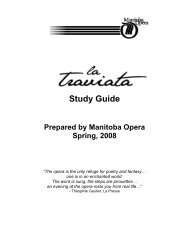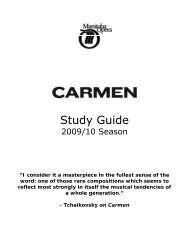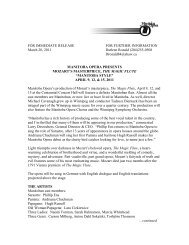The Magic Flute Study Guide - Manitoba Opera
The Magic Flute Study Guide - Manitoba Opera
The Magic Flute Study Guide - Manitoba Opera
Create successful ePaper yourself
Turn your PDF publications into a flip-book with our unique Google optimized e-Paper software.
Portrait of Mozart,<br />
1763-64<br />
Family Life in the 18th Century<br />
Marriage, children, economic circumstances and social status were<br />
closely linked during the 1700s. <strong>The</strong> majority of families were<br />
termed “the middling class” or the middle class, a status of family<br />
that was non-existent before the 18th century. During the 1600s<br />
people were either wealthy and privileged or utterly poor and there<br />
was no in-between whatsoever. <strong>The</strong> rise of the middle class began<br />
during the 18th century and its impact upon family was enormous.<br />
Women and men of the upper classes did not marry for love. Instead, they married strictly for<br />
financial and social reasons. Women who wished to continue living within a wealthy household simply<br />
did not marry a man of the middle or lower class. A self-respecting gentleman didn’t even consider<br />
marrying a woman from a poor family. It was unlikely she would possess the social graces and dowry<br />
required to marry into such a society. Moreover, rumors would abound as to why a wealthy young<br />
man would wed a girl of such poor means. Perhaps he had gotten her “in the family way” and was<br />
inclined to do right by her? Such humiliation could never be visited upon his family.<br />
<strong>The</strong> middle class on the other hand could marry whomever they liked. It wasn’t sensible for a middleclass<br />
women to marry a poor man since her children would be raised in poverty, yet if her happiness<br />
depended upon it, her family was unlikely to intervene. <strong>The</strong>re was no need to marry for social status<br />
or wealth since the middle class did not possess either.<br />
Yet the concept of the middle class was still one of privilege. Up until the 18th century, childhood, like<br />
the middle class, did not exist. <strong>The</strong> lower class worked hard to eke out a living and their children were<br />
expected to work alongside them. School was a privilege that only the upper class could afford. And<br />
well into the 18th century childhood still did not exist for the lower class.<br />
<strong>The</strong> Industrial Revolution set into motion incredible changes in 1700s society. <strong>The</strong> vast majority of<br />
people who worked inside the new factories producing items such as farm equipment, clothing and<br />
toys were of the lower class. Not surprisingly, lower class children also worked inside these factories<br />
earning far less than their parents’ meager wage. Children labored as hard as their parents, often<br />
carrying heavy loads of materials or sitting at industrial machines for countless hours inside<br />
deplorable factory conditions. Had the term “sweatshop” been coined at that time, then it would<br />
indeed have described the factories where these lower class families labored.<br />
<strong>The</strong> middle and upper classes however did not set foot inside of a factory. Children of the middle class<br />
began to attend school for the first time in history. Only farmers’ children took time away from school<br />
for significant periods in order to assist with the sowing and harvesting of crops during the summer<br />
and autumn months.<br />
<strong>The</strong> dominant household figure was the father. It was he who determined<br />
whether or not his wife could work outside the home or whether or not his<br />
children were to attend school. He owned all of the family’s property and money.<br />
Divorce was exceedingly rare since women who left their husbands had no viable<br />
means of survival. Mothers usually remained at home, keeping a hearth and<br />
producing several children. <strong>The</strong>ir job was not an easy one. Mothers cleaned the<br />
house, made clothing for their families by hand, cooked, minded the children,<br />
tended a garden and generally tried to please their husbands. Women’s social<br />
status was well below that of men’s and they seldom questioned any of their<br />
husbands’ decisions.<br />
Yet many upper and middle class families were quite content during the 18th<br />
century. <strong>The</strong> Industrial Revolution generated excitement about new technologies meant to make life<br />
easier. Marriages were usually harmonious, children were treated kindly and a belief in God was<br />
extremely important. <strong>The</strong> inherent goodness in people provided a solid backbone for families and<br />
produced a law-abiding and civilized society in which families flourished.<br />
29<br />
Mozart’s mother<br />
Anna Maria, 1775








